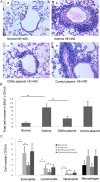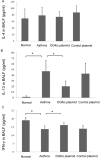DGKα DNA vaccine relieves airway allergic inflammation in asthma model possibly via induction of T cell anergy
- PMID: 24228102
- PMCID: PMC3816809
DGKα DNA vaccine relieves airway allergic inflammation in asthma model possibly via induction of T cell anergy
Abstract
Induction of T cell immune tolerance is thought to be a good method for treatment of asthma. Diacylglycerol kinases alpha (DGKα), enzymes that catalyze phosphorylation of diacylglycerol to produce phosphatidic acid, could inhibit diacylglycerol (DAG)-mediated signaling following T-cell receptor engagement and prevent T cell hyperactivation, thus playing important roles in the induction of T cell anergy. In the present study, we aimed to investigate the effects of DNA vaccine encoding DGKα gene administration on allergen-induced airway allergic inflammation in the murine model of asthma. Animal models were created and plasmid containing DGKα were constructed. Cytokine production was detected after the administration of DGKα gene plasmid. Immunization of mice with alum-adsorbed ovalbumin (OVA) followed by challenged with inhalation of aerosolized OVA resulted in the development of airway allergic inflammation. Administration of DGKα gene before the aerosolized OVA challenge significantly decreased the allergic airway inflammation and eosinophil infiltration in bronchoalveolar lavage fluid (BALF). Immunization with DGKα DNA vaccine decreased OVA-specific IgE and interleukin 13 (IL-13) levels in sera, and increased the IFN-γ level in BALF. The results of the present study provide evidence for the potential utility of the administration of DGKα DNA vaccine as an approach to gene therapy for asthma.
Keywords: Asthma; DNA vaccine; airway inflammation; diacylglycerol kinases alpha.
Figures





Similar articles
-
Potential therapy of Fc-antigen combination-encoding DNA vaccination in mouse allergic airway inflammation.Clin Exp Immunol. 2008 Oct;154(1):115-22. doi: 10.1111/j.1365-2249.2008.03736.x. Epub 2008 Aug 22. Clin Exp Immunol. 2008. PMID: 18727625 Free PMC article.
-
Induced pluripotent stem cells without c-Myc reduce airway responsiveness and allergic reaction in sensitized mice.Transplantation. 2013 Dec 15;96(11):958-65. doi: 10.1097/TP.0b013e3182a53ef7. Transplantation. 2013. PMID: 23989473
-
Experimental protocol for development of adjuvant-free murine chronic model of allergic asthma.J Immunol Methods. 2019 May;468:10-19. doi: 10.1016/j.jim.2019.03.002. Epub 2019 Mar 14. J Immunol Methods. 2019. PMID: 30880263
-
DGKα, Bridging Membrane Shape Changes with Specific Molecular Species of DAG/PA: Implications in Cancer and Immunosurveillance.Cancers (Basel). 2022 Oct 26;14(21):5259. doi: 10.3390/cancers14215259. Cancers (Basel). 2022. PMID: 36358678 Free PMC article. Review.
-
The Roles of Diacylglycerol Kinase α in Cancer Cell Proliferation and Apoptosis.Cancers (Basel). 2021 Oct 16;13(20):5190. doi: 10.3390/cancers13205190. Cancers (Basel). 2021. PMID: 34680338 Free PMC article. Review.
Cited by
-
DGKα in Neutrophil Biology and Its Implications for Respiratory Diseases.Int J Mol Sci. 2019 Nov 13;20(22):5673. doi: 10.3390/ijms20225673. Int J Mol Sci. 2019. PMID: 31766109 Free PMC article. Review.
-
Establishment and Epitope Mapping of Anti-Diacylglycerol Kinase α Monoclonal Antibody DaMab-8 for Immunohistochemical Analyses.Monoclon Antib Immunodiagn Immunother. 2020 Feb;39(1):1-5. doi: 10.1089/mab.2019.0004. Epub 2019 May 17. Monoclon Antib Immunodiagn Immunother. 2020. PMID: 31099705 Free PMC article.
References
-
- Broide DH, Finkelman F, Bochner BS, Rothenberg ME. Advances in mechanisms of asthma, allergy, and immunology in 2010. J Allergy Clin Immunol. 2011;127:689–695. - PubMed
-
- Lowrey JL, Savage ND, Palliser D, Corsin-Jimenez M, Forsyth LM, Hall G, Lindey S, Stewart GA, Tan KA, Hoyne GF, Lamb JR. Induction of tolerance via the respiratory mucosa. Int Arch Allergy Immunol. 1998;116:93–102. - PubMed
-
- van Rijt LS, van Kessel CH, Boogaard I, Lambrecht BN. Respiratory viral infections and asthma pathogenesis: a critical role for dendritic cells? J Clin Virol. 2005;34:161–169. - PubMed
-
- Afshar R, Medoff BD, Luster AD. Allergic asthma: a tale of many T cells. Clin Exp Allergy. 2008;38:1847–1857. - PubMed
Publication types
MeSH terms
Substances
LinkOut - more resources
Full Text Sources
Other Literature Sources
Medical
